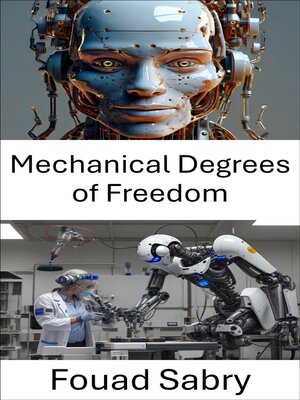Mechanical Degrees of Freedom
ebook ∣ Understanding Movement and Control in Robotic Systems · Robotics Science
By Fouad Sabry

Sign up to save your library
With an OverDrive account, you can save your favorite libraries for at-a-glance information about availability. Find out more about OverDrive accounts.
Find this title in Libby, the library reading app by OverDrive.



Search for a digital library with this title
Title found at these libraries:
| Library Name | Distance |
|---|---|
| Loading... |
Unlock the essential knowledge of mechanics and robotics with "Mechanical Degrees of Freedom," an indispensable resource for professionals, students, and enthusiasts alike. This book delves deeply into the core principles of robotics, mechanics, and kinematics, offering a structured, comprehensive guide that will sharpen your understanding of multibody systems, inverse kinematics, and much more. Whether you're an undergraduate, graduate student, or a seasoned engineer, this work will empower you to explore the complexities of robotic systems and their applications in modern engineering. Dive in and enhance your expertise in the foundational concepts that drive the robotics field forward
Degrees of freedom (mechanics)-Understand the core concept of mechanical degrees of freedom and their application in rigid body mechanics
Machine-Explore the fundamental principles of machines and how they relate to mechanical systems and robotic structures
Kinematics-Dive into the study of motion without considering the forces, focusing on the principles that govern robotic movement
Configuration space (physics)-Discover the configuration space concept, crucial for analyzing robotic systems and their possible states
Rigid body dynamics-Examine the movement of solid bodies and the forces acting upon them, key to understanding robot and machine behavior
Inverse kinematics-Learn how inverse kinematics is used to determine the joint movements required for a robot to reach a specific position
Nonholonomic system-Study systems with constraints that cannot be integrated into positional equations, vital for advanced robotics
Robot kinematics-Understand the motion of robots, considering their structure and how they achieve their tasks
Linkage (mechanical)-Explore mechanical linkages and their role in transforming motion and transmitting forces in robotic arms
Overconstrained mechanism-Study mechanisms that have more constraints than necessary, and their implications in robotic design
Six degrees of freedom-Grasp the concept of six degrees of freedom in robotic systems and how they impact mobility and control
Parallel manipulator-Explore parallel manipulators and how they offer precise control in robotics, often used in specialized applications
Multibody system-Understand how interconnected bodies interact in systems like robotic arms and vehicles, essential for complex motion planning
Kinematic pair-Investigate pairs of rigid bodies that are connected and can move relative to each other, a key aspect of robotic movement
Kinematic chain-Learn about kinematic chains, fundamental to the design of robots and mechanisms used in motion analysis
Holonomic constraints-Dive into holonomic constraints, which play a crucial role in controlling robotic movement and ensuring stability
Chebychev–Grübler–Kutzbach criterion-Discover this criterion for analyzing the mobility of mechanisms and its importance in mechanical design
Mechanism (engineering)-Understand the fundamental mechanisms that power machinery, from gears to actuators, and their role in robotics
Kinematics equations-Master the equations that describe the motion of robotic systems, a crucial skill for engineers in the field
Freedom and constraint topologies-Explore the topologies that define freedom and constraints in mechanical systems, key for robotic design
Cartesian parallel manipulators-Delve into the design and function of Cartesian parallel manipulators, known for their accuracy in robotic systems







